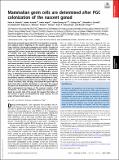Mammalian germ cells are determined after PGC colonization of the nascent gonad
Author(s)
Nicholls, Peter K.; Schorle, Hubert; Naqvi, Sahin; Hu, Yueh-Chiang; Fan, Yuting; Carmell, Michelle A.; Page, David C.; ... Show more Show less
DownloadPublished version (1.899Mb)
Publisher Policy
Publisher Policy
Article is made available in accordance with the publisher's policy and may be subject to US copyright law. Please refer to the publisher's site for terms of use.
Terms of use
Metadata
Show full item recordAbstract
Mammalian primordial germ cells (PGCs) are induced in the embryonic epiblast, before migrating to the nascent gonads. In fish, frogs, and birds, the germline segregates even earlier, through the action of maternally inherited germ plasm. Across vertebrates, migrating PGCs retain a broad developmental potential, regardless of whether they were induced or maternally segregated. In mammals, this potential is indicated by expression of pluripotency factors, and the ability to generate teratomas and pluripotent cell lines. How the germline loses this developmental potential remains unknown. Our genome-wide analyses of embryonic human and mouse germlines reveal a conserved transcriptional program, initiated in PGCs after gonadal colonization, that differentiates germ cells from their germline precursors and from somatic lineages. Through genetic studies in mice and pigs, we demonstrate that one such gonad-induced factor, the RNA-binding protein DAZL, is necessary in vivo to restrict the developmental potential of the germline; DAZL’s absence prolongs expression of a Nanog pluripotency reporter, facilitates derivation of pluripotent cell lines, and causes spontaneous gonadal teratomas. Based on these observations in humans, mice, and pigs, we propose that germ cells are determined after gonadal colonization in mammals. We suggest that germ cell determination was induced late in embryogenesis—after organogenesis has begun—in the common ancestor of all vertebrates, as in modern mammals, where this transition is induced by somatic cells of the gonad. We suggest that failure of this process of germ cell determination likely accounts for the origin of human testis cancer.
Date issued
2019-12Department
Whitehead Institute for Biomedical Research; Massachusetts Institute of Technology. Department of BiologyJournal
Proceedings of the National Academy of Sciences of the United States of America
Publisher
Proceedings of the National Academy of Sciences
Citation
Nicholls, Peter K. et al. “Mammalian germ cells are determined after PGC colonization of the nascent gonad.” Proceedings of the National Academy of Sciences of the United States of America 116 (2019): 25677-25687 © 2019 The Author(s)
Version: Final published version
ISSN
0027-8424